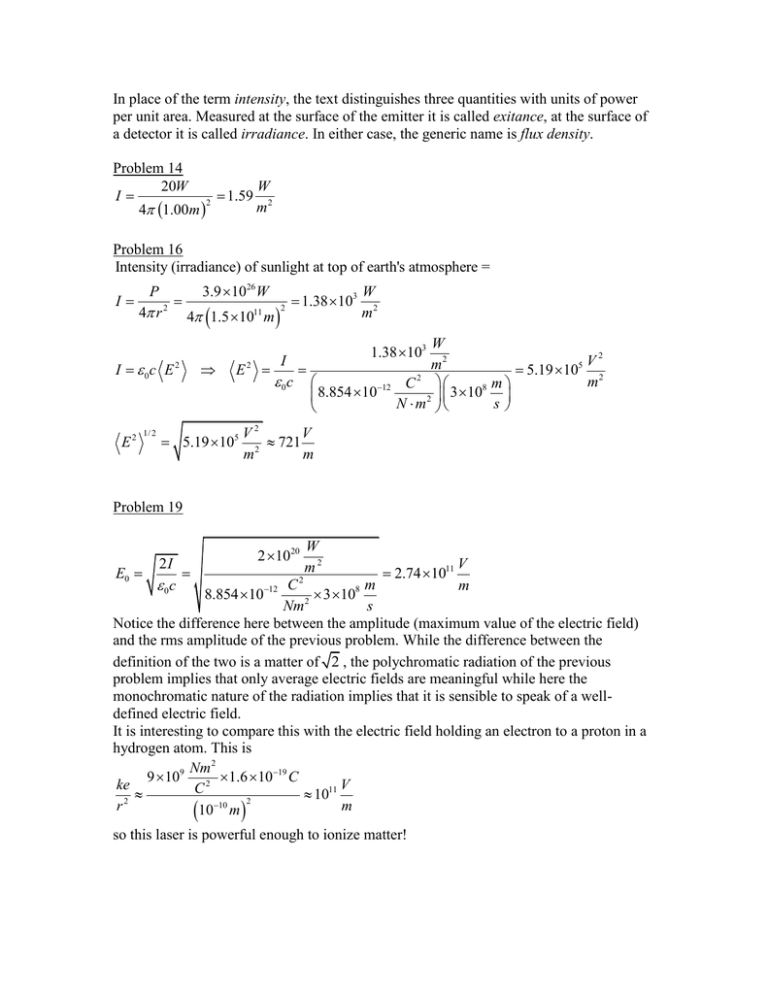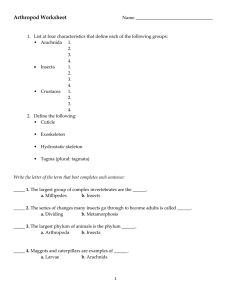advertisement

In place of the term intensity, the text distinguishes three quantities with units of power per unit area. Measured at the surface of the emitter it is called exitance, at the surface of a detector it is called irradiance. In either case, the generic name is flux density. Problem 14 20W W I 1.59 2 2 m 4 1.00m Problem 16 Intensity (irradiance) of sunlight at top of earth's atmosphere = I P 3.9 1026 W W 1.38 103 2 2 2 11 4 r m 4 1.5 10 m I 0c E 2 E 2 1/ 2 E2 I 0c W 2 5 V m2 5.19 10 m2 C2 8 m 3 10 N m2 s 1.38 103 12 8.854 10 V2 V 5.19 10 2 721 m m 5 Problem 19 E0 2I 0c 2 1020 2 W m2 2.74 1011 V m C m 3 108 2 Nm s Notice the difference here between the amplitude (maximum value of the electric field) and the rms amplitude of the previous problem. While the difference between the definition of the two is a matter of 2 , the polychromatic radiation of the previous problem implies that only average electric fields are meaningful while here the monochromatic nature of the radiation implies that it is sensible to speak of a welldefined electric field. It is interesting to compare this with the electric field holding an electron to a proton in a hydrogen atom. This is Nm 2 9 109 2 1.6 1019 C ke V C 1011 2 2 r m 1010 m 8.854 1012 so this laser is powerful enough to ionize matter! Problem 21 v With the insects flying to the right, the number of insects leaving the shaded cross-sectional region shown, of area 1 m2, in a time of 1s is the number of insects contained in the box-like volume shown, with dimension m 1m 1m 0.1 1s 0.1m3 s There are 100 insects per m 3 ,so in a volume of 0.1m3 there will be insects 0.1m3 10 insects 3 m Ten insects per second cross the shaded region. 100 Problem 23 Frequency of 550nm radiation = c 3 108 m s 5.50 107 m In the past we've used the letter "f" for frequency. 5.45 1014 Hz Energy of one photon = h 6.626 1034 Js 5.45 1014 s 1 3.611 1019 J J J 1 photon photons 100W 100 100 2.77 1020 19 s s 3.61110 J s Problem 25 100W W I 7.95 2 2 m 4 1.00m E0 2I 0c 2 7.95 8.854 1012 W m2 2 C m 3 108 2 Nm s V E m 2.58 107 T B0 0 c 3 108 m s 77.4 77.4 V m Problem 38 E E0 cos t kx rad (or f ) = 5.00 1014 Hz s 2 1015 s 1 k 1.61 107 m 1 m 0.65 3 108 s 2 2 3.90 107 m 390nm 7 1 k 1.61 10 m m 3 108 c s 600nm The vacuum wavelength would be 5.00 1014 s 1 600nm n vacuum 1.54 glass 390nm 1015 Problem 44 glass vacuum nglass 500nm 312.5nm 1.60 1 cm 102 m # complete waves 3.20 104 32, 000 9 312.5nm 312.5 10 m


